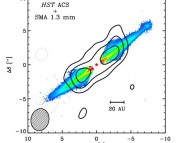Authors: Suvrath Mahadevan, Gudmundur Stefánsson, Paul Robertson, Ryan C. Terrien, Joe P. Ninan, Rae J. Holcomb, Samuel Halverson, William D. Cochran, Shubham Kanodia, Lawrence W. Ramsey, Alexander Wolszczan, Michael Endl, Chad F. Bender, Scott A. Diddams, Connor Fredrick, Fred Hearty, Andrew Monson, Andrew J. Metcalf, Arpita Roy, Christian Schwab
First Author’s Institution: Department of Astronomy & Astrophysics, The Pennsylvania State University, 525 Davey Laboratory, University Park, PA, 16802, USA and the Center for Exoplanets and Habitable Worlds, 525 Davey Laboratory, University Park, PA, 16802, USA
Paper Status: Published Astrophysical Journal, [open access on arXiv]
Peculiar radio signals
A recent paper has found the source of an intriguing radio signal around the star GJ 1181, and no, it wasn’t extra terrestrial intelligence. M dwarf stars like GJ 1151 are small and often radio quiet in their later years, so the detection of any signal at all was puzzling. In addition, the properties of the radio waves were not even the type that typically come from a star. The signal from GJ 1151 had two important features. It was over 8 hours long in duration and had a large amount of circular polarization. Polarization is a property of light that has to do with the direction the wave is oscillating, and only certain kinds of interactions can create circular polarization. This circular polarization combined with the long duration ruled out traditional stellar mechanisms (see this astrobite for more details!). However, this type of radio signal did seem similar to a famous example of radio emission in our solar system.
A similar signal from within our solar system

In the solar system, such a signal is produced by so-called sub-Alfvénic interactions, which was first discovered between Jupiter and its moon Io. As Io orbits around Jupiter, it moves through Jupiter’s magnetic field. Thereby, Io acts like a small conductor and disrupts the magnetic field slightly, causing it to interact differently with any charged particles nearby. Io’s atmosphere is constantly producing charged particles, and when they interact with the disrupted magnetic field low frequency radio emission is created. (Illustrated in Figure 1) The emission comes out highly circular polarized, and the duration of the radio signal relates to Io’s orbit.
Like Jupiter, GJ 1151 has its own magnetic field as well as a source of charged particles from its solar winds. If one draws an analogy between GJ 1151 and Jupiter, then all that would be needed to explain the circular polarized radio emission is if there was a planetary companion to serve the role of Io. Furthermore, it would have to have an orbit that related to the duration of the emission! Original estimates place the planet’s orbital period somewhere between 1 and 5 days.

Right where we expect it to be
After a few searches by different parts of the community, today’s authors have claimed to have indeed found a planet at an orbital period of 2 days. They used the radial velocity method of detecting exoplanets, which uses the gravitational pull between the planet and the star. A star will wobble or move slightly if there is a planet pulling the star over the course of its orbit. The scientists were able to measure the speed of the star multiple times with the Habitable-Zone Planet finder instrument on the McDonald Observatory, and combined them with related existing measurements. They noticed that GJ 1151 seemed to wobble just as if there were a planet, and the wobbling repeated approximately every 2 days. (Figure 2) With that orbital period, the planet is precisely where it should be to create a sub-Alfvénic interaction with GJ 1151, and so it is considered a likely cause for the mysterious radio emission (although another paper has created a debate to whether the detection is real).
While this could be a satisfying source of the radio emission, (and again, it’s definitely not aliens!) what is more exciting is the prospect of using this technique to find more exoplanets. Most exoplanets are found rather tediously by surveying thousands of stars not knowing which stars have or do not have detectable planetary companions. The star-planet interactions from today’s paper can potentially become an invaluable tool for further searches. Who needs aliens saying “look here”, when we can listen to a signal from the planet itself telling us precisely where to search.
Astrobite edited by Konstantin Gerbig
Featured image credit: adapted from wikiHow with elements pulled from memegenerator and SIMBAD.




